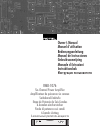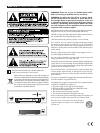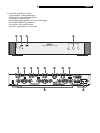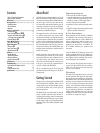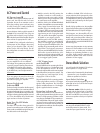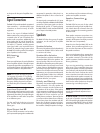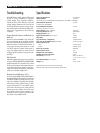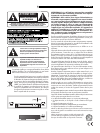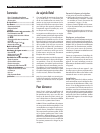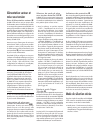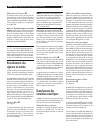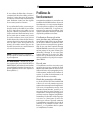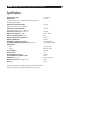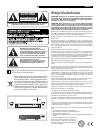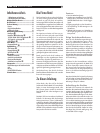
7
English
to the inputs for that pair of amplifier chan-
nels.
Signal Connections
The RMB-1076 provides standard conventional
input connections — unbalanced RCA type
connections as found on nearly all audio
equipment.
There is also a pair of SIGNAL OUTPUT
LINK connections for passing the input signal
connected to the “A” pair of channels on to
another audio component. Additionally, the
input signal to the “A” pair of channels can
be automatically linked to the inputs for the
“B” and/or “C” channels, so that a separate
input signal cable is not required for those
channels, for example in large systems where
the RMB-1076 is being used to drive multiple
pairs of speakers in stereo mode.
RCA Inputs
5
See Figure 2
There are two RCA inputs for each of the three
pairs of amplifier channels. These RCA inputs
accept audio signals from preamplifiers or sur
-
round sound processors. Use high quality audio
interconnect cables for best performance.
NOTE: You can link the inputs for group
“A” to groups “B” and/or “C” by placing
the INPUT SELECT switch in the left LINK
position. No input connection is required for
that group. Placing the switch in this posi-
tion leaves that pair of channels in Stereo
mode.
Input Level Controls
4
Three controls on the front panel, one for each
pair of amplifier channels, provide input level
adjustments. These allow you to adjust the gain
of the amplifiers to match other components
in an elaborate system.
Turn the small knob clockwise to increase
gain. Turn the knob counterclockwise to
reduce gain.
Signal Output Link
7
This pair of RCA connections can be used to
pass unprocessed input signals to another audio
component, for example to “daisy-chain” an
additional amplifier to drive a second set of
speakers.
The input signals connected to the “A” inputs
are always available at SIGNAL OUTPUT LINK
connections. These input signals can also be
linked to the “B” and/or “C” inputs by playing
the INPUT SELECT switch associated with that
pair of inputs in the LINK position.
Speakers
The RMB-1076 has three groups of speaker
connectors, one for each pair of amplifier
channels.
Speaker Selection
The nominal impedance of the loudspeaker(s)
connected to the RMB-1076 in Stereo mode
is a minimum of 4 ohms.
Speaker Wire Selection
Use insulated two-conductor stranded wire to
connect the RMB-1076 to the speakers. The
size and quality of the wire can have an au-
dible effect on the performance of the system.
Standard speaker wire will work, but can result
in lower output or diminished bass response,
particularly over longer distances. In general,
heavier wire will improve the sound. For best
performance, you may want to consider special
high-quality speaker cables. Your authorized
Rotel dealer can help in the selection of ap
-
propriate cables for your system.
Polarity and Phasing
The polarity – the positive/negative orientation
of the connections – for every speaker and
amplifier connection must be consistent so all
the speakers will be in phase. If the polarity
of one connection is mistakenly reversed, bass
output will be very weak and stereo imaging
degraded. All wire is marked so you can
identify the two conductors. There may be ribs
or a stripe on the insulation of one conductor.
The wire may have clear insulation with dif
-
ferent color conductors (copper and silver).
There may be polarity indications printed on
the insulation. Identify the positive and nega
-
tive conductors and be consistent with every
speaker and amplifier connection.
Speaker Connections
0
See Figure 2
The RMB-1076 has two pair of color coded
connections for each group of amplifier chan
-
nels. Labels above the connectors show the
proper connections for connecting speakers
in Stereo mode.
These speaker connectors accept bare wire,
connector lugs, or “banana” type connectors
(except in the European Community countries
where their use is not permitted).
Route the wires from the RMB-1076 to the
speakers. Give yourself enough slack so you
can move the components to allow access to
the speaker connectors.
If you are using banana plugs, connect them
to the wires and then plug into the backs of
the speaker connectors. The collars of the
speaker connectors should be screwed in all
the way (clockwise).
If you are using terminal lugs, connect them
to the wires. If you are attaching bare wires
directly to the speaker connectors, separate the
wire conductors and strip back the insulation
from the end of each conductor. Be careful
not to cut into the wire strands. Unscrew (turn
counterclockwise) the speaker connector col
-
lar. Place the connector lug around the shaft,
or insert the bundled wire into the hole in the
shaft. Turn the collars clockwise to clamp the
connector lug or wire firmly in place.
NOTE: Be sure there are no loose wire
strands that could touch adjacent wires or
connectors.
In Stereo mode: Connect the left speaker
to the pair of speaker connectors labeled
LEFT. Connect the right speaker to the speaker
connectors labeled RIGHT. Follow the labels
printed above the connectors, observe cor
-
rect polarity.



